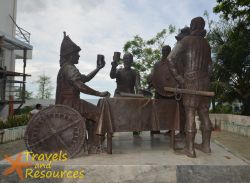 The first stop on our Bohol City tour was the Blood Compact Site commemorating the unity of Rajah Sikatuna and Miguel Lopez de Legazpi back on March 16, 1565. Just like olden time, both men would make a small incision in their arms with a blade and collect their blood with a goblet before drinking it.
The first stop on our Bohol City tour was the Blood Compact Site commemorating the unity of Rajah Sikatuna and Miguel Lopez de Legazpi back on March 16, 1565. Just like olden time, both men would make a small incision in their arms with a blade and collect their blood with a goblet before drinking it.
Table of Contents
Brief Background
Prior to the arrival of Miguel Lopez de Legazpi leading a Spanish fleet, Portugal had already visited Bohol years earlier. But instead of coming in friendship, they came to enslave as many as 1,000 of the locals, also known as Boholanos.
With other provinces having experienced slavery from the Portuguese, it is probably no wonder that Miguel Lopez de Legazpi wasn’t well received. It was only in Bohol, after capturing a ship filled with Malayan sailors that that Miguel Lopez de Legazpi was able to inform the local Rajahs, or chiefs, that he came in peace to trade.
Thanks to the Malayan translators, the Boholanos understood that Miguel Lopez de Legazpi represented the Spanish, and not the Portuguese, and welcomed him and his men. To seal their friendship, both parties made a blood compact, known locally as Sandugo and loosely translates into one blood.
The Site
The site is composed of a bronze table and statues depicting people toasting before drinking the goblets. They are all mounted on a marble pedestal big enough to allow tourists to stand around them for pictures. Behind and below the site is a river leading to the sea, which is partly obscured due to the healthy growth of trees around the area.

Blood Compact Site
During my first visit to the Blood Compact Site, our guide mentioned that this was the actual place where Rajah Sikatuna and Miguel Lopez de Legazpi had the blood compact. However, this was not without argument as historians point to another site.
Being my second visit to Bohol, it looks like the location of the actual Blood Compact Site has been settled. Our guide Michael informed us that this is not the actual place and that the Sandugo took place further away. And while that may disappoint serious historians, the current place is still a good representation of that incident.
Incidentally, people need to remember is that no one is allowed to jump or sit on the table or hand on any of the statues. Being made of bronze, putting weight or scuffing the surface will eventually damage it. Getting between the statues is fine for picture-taking, though.
Souvenir Shop
There is a souvenir shop beside the Blood Compact Site that offers quite a few unique items. One of the things that caught my attention were the miniature wooden oars and scuba diving tanks. There was also a tiny wooden sign listing some of Bohol’s more famous dive sites.
If this is something you would like to purchase, you may want to get a set before heading out to the next tour destination because I didn’t see it in any other place during the time of our visit.
Camera Tips
Taking pictures shouldn’t be a problem for any camera, whether mobile phone, compact digital, or dSLR. The Blood Compact Site is open and exposed to the sun so should be enough light, even on a cloudy day.

Blood Compact Site
Typical zoom lenses for compact digital and dSLR cameras also fine because there is enough space to back up and get the entire site in the picture.
However, I’ve noticed that the details of the statues was lost in some of my pictures because of the way the camera adjusts to the bright sunlight. Apart from tweaking your camera to handle the shadows, a quick solution may be to use a flash, whether built-in or external, to light up the dark areas.
Incidentally, you may be approached by some of the locals who take your picture and print them out with the Blood Compact border and logo. Don’t worry as they won’t continue hassling you if you don’t wish to buy a picture for PhP 250. And while it is a bit pricey, the border and logo one the picture made it a nice souvenir so we got one with our entire family in it. Besides that, it helps the local economy.
Final Thoughts
On March 16, 1565, the Sandugo became the first treaty of friendship between the Spain and the people of the Philippines. The memory of this occasion has been immortalized in the Blood Compact Site in Bohol.
And while there are certainly pros and cons to the Spanish occupation of the country, this occasion made it possible for the Philippines to develop its own unique culture.
Must Do’s
- Take lots of pictures.
- Consider using your flash to get details of the statues.
- Consider buying a souvenir picture as it helps the local economy.
Must Don’ts
- Don not sit on the table or hand on the statues.


Comments are closed